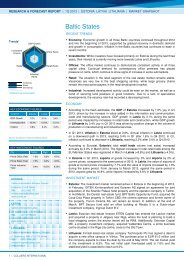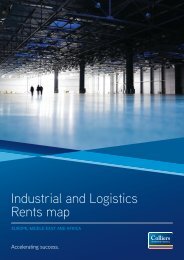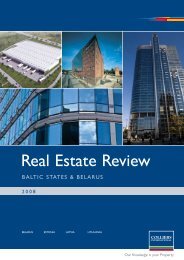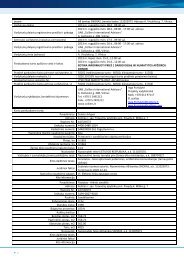baltic states and belarus real estate market review - Colliers
baltic states and belarus real estate market review - Colliers
baltic states and belarus real estate market review - Colliers
Create successful ePaper yourself
Turn your PDF publications into a flip-book with our unique Google optimized e-Paper software.
Real Estate Market Review 2011 | Belarus Retail Market<br />
Retail Market<br />
Billion EUR<br />
Dynamics of retail<br />
turnover in the Republic<br />
Belarus<br />
Source: National Statistics Committee of the<br />
Republic of Belarus<br />
20<br />
18<br />
16<br />
14<br />
12<br />
10<br />
8<br />
6<br />
4<br />
2<br />
0<br />
2004<br />
2005<br />
Billion EUR<br />
2006<br />
2007<br />
2008<br />
2009<br />
Percent of previuos year<br />
2010<br />
Structure of retail sales<br />
Source: National Statistics Committee of the<br />
Republic of Belarus<br />
80%<br />
70%<br />
60%<br />
50%<br />
40%<br />
30%<br />
20%<br />
2004 2005 2006 2007 2008 2009 2010<br />
Food goods Non-food goods<br />
140%<br />
120%<br />
100%<br />
80%<br />
60%<br />
40%<br />
20%<br />
0%<br />
OVERVIEW<br />
2010 can be considered as a year of recovery<br />
in the retail <strong>and</strong> services segments in<br />
Belarus. Retail turnover in Local currency<br />
(Belorussian Rubles) increased by 17.1 per<br />
cent relative to 2009. Retail turnover in EUR<br />
figures increased by 25.4 per cent, amounting<br />
to 17.6 billion EUR This figure is 1.5 billion<br />
more than in 2008, which was previously the<br />
most successful year for the Belarusian<br />
retail. It is necessary to consider a major<br />
factor in the increase of EUR turnover was<br />
due to the fluctuation <strong>and</strong> devaluing of the<br />
EUR currency exchange rate. This is evident<br />
when it is considered that the increase of<br />
retail turnover in USD amounted to just 0.3<br />
billion for the same period.<br />
Food retailers were the most stable type of<br />
retail operation during the crisis.<br />
The retail turnover structure also underwent<br />
some changes. In 2009 there was a dramatic<br />
decrease of sales volume <strong>and</strong> an increase of<br />
the share of foods in sales structure. In 2010<br />
the share of foods decreased by 1 percentage<br />
point, amounting to a 50.1 per cent share of<br />
the total sales. An increase in <strong>real</strong> wages<br />
saw further reduction of food sales in the<br />
total retail sales volume.<br />
Emergence of retail chains (“convenience<br />
stores“, super<strong>market</strong>s <strong>and</strong> hyper<strong>market</strong>s)<br />
became the main trend in the retail <strong>market</strong> in<br />
2010. Development mainly took place in<br />
regional areas because of fierce competition<br />
in Minsk’s retail segment.<br />
Decrease of non-foods in retail sales<br />
structure as the consequence of crisis is<br />
ongoing <strong>and</strong> is constraining development<br />
actively in segments such as home appliances<br />
<strong>and</strong> clothing. Among non-food retailers<br />
“Buslik”, which operates children’s’ product<br />
stores <strong>and</strong> has demonstrated active<br />
development.<br />
In regional areas “convenience stores”<br />
developed most actively. Such stores can be<br />
opened in existing retail properties.<br />
Super<strong>market</strong> <strong>and</strong> hyper<strong>market</strong> chains have<br />
to construct new ‘built to suit’ objects. 2010<br />
also saw the start of new properties <strong>and</strong> the<br />
completion of projects that were suspended<br />
in 2008 - 2009.<br />
In 2010 the majority of regional projects<br />
were implemented in Gomel, the second<br />
largest city by population in Belarus with<br />
482,000 inhabitants. Hyper<strong>market</strong> chain<br />
“Hyppo”, super<strong>market</strong>s “Almi” <strong>and</strong> “Korzinka<br />
were opened in Gomel during the year, with<br />
an area of the objects exceeding 16,000 sqm.<br />
The company “Grinn” constructed it’s first<br />
store of “cash& carry” store (self-service<br />
store, offering customers the opportunity to<br />
purchase various goods at retail <strong>and</strong> small<br />
wholesale) with a total area of 14,000 sqm.<br />
This chain operates 18 hyper<strong>market</strong>s <strong>and</strong> 20<br />
super<strong>market</strong>s in different regions of Russia.<br />
The further development of the chain is going<br />
to be directed to regional centres of Belarus<br />
also. Another notable development was by<br />
the company “Rakovski Kirmash”, who<br />
opened a new food super<strong>market</strong> under a roof<br />
of the former operator after a partial<br />
reconstruction.<br />
SUPPLY AND NEW CONSTRUCTION<br />
During 2010, 8 shopping centres <strong>and</strong><br />
complexes with a large retail portion were<br />
put into operation. The total GLA of these<br />
objects is 59,000 sqm. Completion of a<br />
further 5 objects with 22,000 sqm of area<br />
has been delayed to 2011.<br />
The delay of project completion was a typical<br />
trend even before the crisis, aggravated by<br />
the financial problems of some developers<br />
<strong>and</strong> froze some projects in 2009. At the<br />
same time large Belarusian <strong>and</strong> foreign<br />
companies constructed retail objects with a<br />
timeframe of under a year. 2Q 2010 saw the<br />
opening of shopping centre ProStore with<br />
total area of 20,600 sqm <strong>and</strong> DIY shopping<br />
centre OMA with total area 8,500 sqm.<br />
The existing supply is predominately<br />
neighbourhood <strong>and</strong> community shopping<br />
centres. The GLA of such objects generally<br />
doesn’t exceed 5,000 <strong>and</strong> 15,000 sqm<br />
respectively Many objects do not have an<br />
anchor tenant.<br />
There are currently only two centres large<br />
enough to be considered “regional shopping<br />
centres” on the <strong>market</strong>.<br />
CONTACTS: ANDREY PAVLYSHKO - a.pavlyshko@colliers.by l ANDREY ALESHKIN - a.aleshkin@colliers.by<br />
<strong>Colliers</strong> International | p. 83













